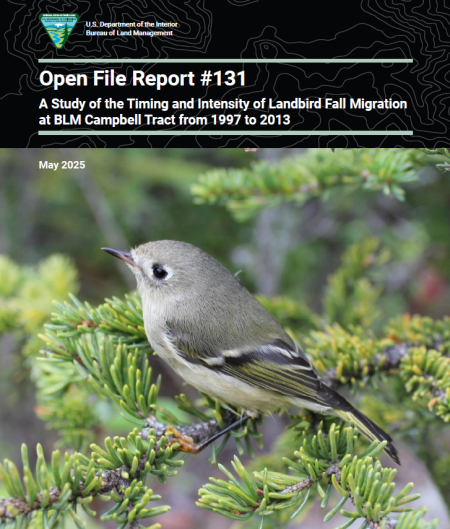A Study of the Timing and Intensity of Landbird Fall Migration at BLM Campbell Tract from 1997 to 2013 OFR 131

The timing and intensity of landbird fall migration was studied at Campbell Tract in Anchorage, Alaska, from 1997–2013 using mist netting and banding of birds. A total of 12,082 individual birds from 36 species were captured and banded during 14,215 net hours of mist netting. The 10 most abundant species captured were slate-colored junco, ruby-crowned kinglet, myrtle warbler, Wilson’s warbler, hermit thrush, orange-crowned warbler, yellow warbler, black-capped chickadee, golden-crowned kinglet, and fox sparrow. The average capture rate (number of birds captured per 100 net hours) for all 36 species was 82. The average capture rate for after hatch year (AHY), or adult, birds was 7. The average capture rate for hatch year (HY) birds was 79. The proportion of HY birds captured averaged 86% and ranged from 71% to 94%. Weak positive relationships were found between capture rates of AHY and HY birds and summer temperature and precipitation. A weak negative relationship was also found between AHY capture rates and average summer temperatures. The timing and intensity of the fall migration varied among years with peaks in capture rates for all species changing from late August to mid-September. A-type and B-type Neotropical migrant birds comprised between 73% and 97% of individual birds captured at the Campbell Tract banding station in fall for years 1997–2013, averaging 88% across all years. A total of 185 individual birds of 10 species returned to the station from 1 to 4 years after banding and included both resident and migrant species. Eight birds of four species banded at Campbell Tract were recovered at other locations and included yellow warbler, slate-colored junco, hermit thrush, and black-capped chickadee.
